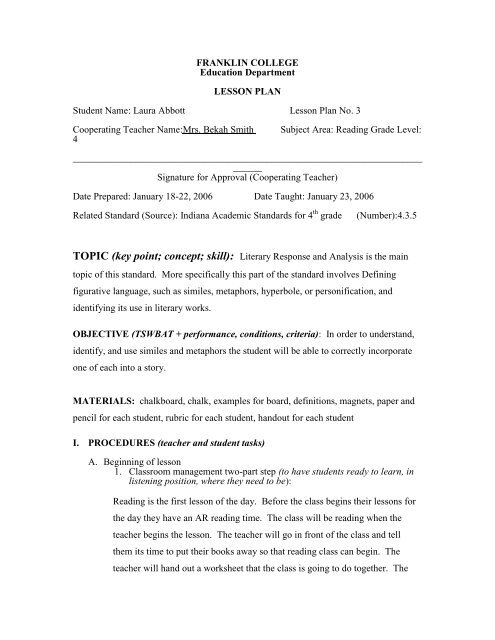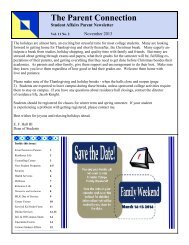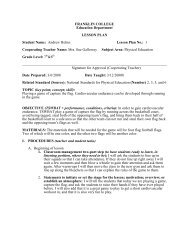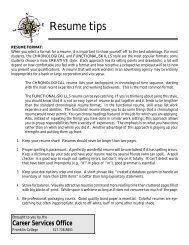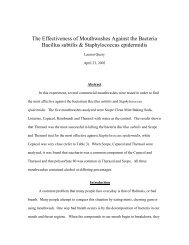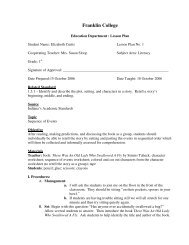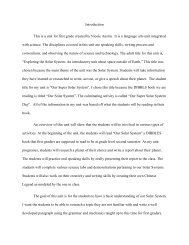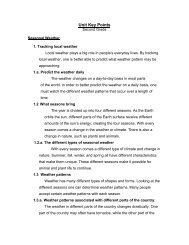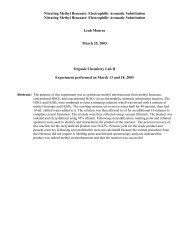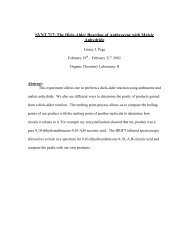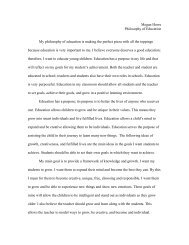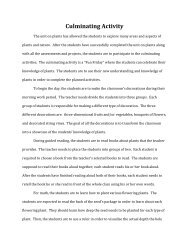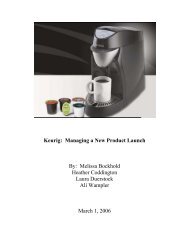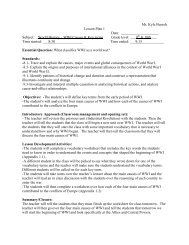Similes and Metaphors - Franklin College
Similes and Metaphors - Franklin College
Similes and Metaphors - Franklin College
You also want an ePaper? Increase the reach of your titles
YUMPU automatically turns print PDFs into web optimized ePapers that Google loves.
FRANKLIN COLLEGE<br />
Education Department<br />
LESSON PLAN<br />
Student Name: Laura Abbott Lesson Plan No. 3<br />
Cooperating Teacher Name:Mrs. Bekah Smith Subject Area: Reading Grade Level:<br />
4<br />
________________________________________________________________________<br />
______<br />
Signature for Approval (Cooperating Teacher)<br />
Date Prepared: January 18-22, 2006 Date Taught: January 23, 2006<br />
Related St<strong>and</strong>ard (Source): Indiana Academic St<strong>and</strong>ards for 4 th grade (Number):4.3.5<br />
TOPIC (key point; concept; skill): Literary Response <strong>and</strong> Analysis is the main<br />
topic of this st<strong>and</strong>ard. More specifically this part of the st<strong>and</strong>ard involves Defining<br />
figurative language, such as similes, metaphors, hyperbole, or personification, <strong>and</strong><br />
identifying its use in literary works.<br />
OBJECTIVE (TSWBAT + performance, conditions, criteria): In order to underst<strong>and</strong>,<br />
identify, <strong>and</strong> use similes <strong>and</strong> metaphors the student will be able to correctly incorporate<br />
one of each into a story.<br />
MATERIALS: chalkboard, chalk, examples for board, definitions, magnets, paper <strong>and</strong><br />
pencil for each student, rubric for each student, h<strong>and</strong>out for each student<br />
I. PROCEDURES (teacher <strong>and</strong> student tasks)<br />
A. Beginning of lesson<br />
1. Classroom management two-part step (to have students ready to learn, in<br />
listening position, where they need to be):<br />
Reading is the first lesson of the day. Before the class begins their lessons for<br />
the day they have an AR reading time. The class will be reading when the<br />
teacher begins the lesson. The teacher will go in front of the class <strong>and</strong> tell<br />
them its time to put their books away so that reading class can begin. The<br />
teacher will h<strong>and</strong> out a worksheet that the class is going to do together. The
teacher will read the definitions of similes <strong>and</strong> metaphors <strong>and</strong> then read the<br />
definitions of each. The teacher will ask a student why each example is a<br />
simile or metaphor. The teacher will also have student say what is being<br />
compared in each sentence. Once the student explains it the class will work on<br />
identifying them together.<br />
2. Statements to initiate or set the stage for the lesson; motivation; overview;<br />
or establish an atmosphere:<br />
The teacher will ask for eight volunteers (that is how many examples there<br />
will be). Students enjoy volunteering to do things in class, especially when<br />
the task allows them to get out of their desks <strong>and</strong> move around the<br />
classroom. Each student will by told to pick on sentence off of the board<br />
<strong>and</strong> place it in the correct column.<br />
B. Instruction Steps:<br />
1. Next the teacher will call on each student who volunteered to have them<br />
explain why they put their sentence in the column that they did. The<br />
teacher will help the student if he or she can not explain the reasoning.<br />
2. The student will also have to say what two things are being compared in<br />
the sentence that he or she placed on the board.<br />
3. The class will be instructed to look at their worksheet because the<br />
sentences on the board are also on this. They will be told to circle the<br />
correct answer on this paper as the class goes through the examples on the<br />
board.<br />
4. Next the teacher will h<strong>and</strong> out the assignment rubric <strong>and</strong> an example of<br />
what the class will have to do for their work.<br />
5. The teacher will go through the entire rubric so that the class is sure of<br />
what they will need to do to get all of the points for the assignment. The<br />
teacher will ask students what they need to have to get an A. This will<br />
help the student remember all of the things that they need to do.
6. Now the class will be told to turn over the paper where they will find an<br />
example story. The teacher will have a student read the story out loud.<br />
After the story has been read the teacher will ask the students to pick out<br />
the similes <strong>and</strong> metaphors. The students will be asked how they knew<br />
which sentence contained one of them, which one it was, why it was that<br />
one, <strong>and</strong> what two things were being compared in the sentence.<br />
Closure statement (brief lesson review, summary; doesn’t have to be the<br />
last step if something is going to be made or an activity will follow<br />
After the example story has been read, the class will be asked to volunteer<br />
some of their own similes <strong>and</strong> metaphors after having a few moments to think.<br />
The students will first tell their sentence, then which one it is, why it is that<br />
one <strong>and</strong> what two things are being compared in the sentence.<br />
7. After this is done, the class will have the rest of the reading lesson time to<br />
write their stories. If they have questions with what is required of them, or<br />
how to write a simile or metaphor they can ask the teacher during this quiet<br />
work time.<br />
ASSESSMENT (how is objective met by students: observation, written work,<br />
presentations, quiz etc.):<br />
The students are to individually write an original story that follows the given topic. The<br />
story will be graded according to the rubric made be the teacher. Each student will have<br />
a copy of the rubric in order for them to know what they must include to receive an A.<br />
III. EXTENSION AND REMEDIATION (what will be done beyond lesson;<br />
strategies for those who need further instruction, assistance:<br />
The amount of extension for an individual student depends on how much time is left<br />
during the class period when that student gets finished with the assignment. If there is<br />
ten minutes or less left in the class period, that student will be told to read an AR book or<br />
illustrate the story that was just written. If the student has more than ten minutes left in
the class period, that student will be told to either add more similes <strong>and</strong> metaphors to<br />
their story or add another paragraph. Also, the student who finishes early will be told to<br />
proofread the story one more time <strong>and</strong> check it with the rubric to make sure that<br />
everything required has been put in the story.<br />
The extension for the whole class will be similar. If the class finishes early, they will be<br />
told to add more similes <strong>and</strong> metaphors to their story. Also, they will be instructed to add<br />
additional paragraphs. If they finished with only a few minutes left in the lesson they<br />
will be instructed to read for AR. Any student who finishes early will be allowed to<br />
illustrate their story <strong>and</strong> add additional touches to make it creative.<br />
Remediation for an individual student would be to work with the student one on one<br />
while the rest of the class is writing their stories. The teacher will go through the<br />
definitions <strong>and</strong> examples again <strong>and</strong> then have the student explain why each example is a<br />
simile or metaphor. If this still does not help the student underst<strong>and</strong>, the teacher will help<br />
the student to make his or her own examples.<br />
Remediation for the whole class will be similar. The teacher will go over the definitions<br />
for each example. With each example the teacher will have one student choose which<br />
one it is <strong>and</strong> then explain why it is that one. Then the teacher will go over the example<br />
again by saying which one it is <strong>and</strong> why it is that one.<br />
HOMEWORK ASSIGNMENT(S): The homework is to complete the story as<br />
specified on the rubric. It will be due the following day.
Definitions:<br />
<strong>Similes</strong> <strong>and</strong> <strong>Metaphors</strong><br />
Simile-a comparison of two unlike things using like or as<br />
Metaphor-a comparison of two unlike things without using like or as; an implied<br />
comparison<br />
Examples:<br />
<strong>Similes</strong><br />
1. She was as cool as a cucumber.<br />
2. When she woke up her hair looked like a lion’s mane.<br />
<strong>Metaphors</strong><br />
1. You are the wind beneath my wings.<br />
2. The elephant was a bulldozer because he ran over the tree <strong>and</strong> knocked it down.<br />
Decide whether the sentence contains a simile or a metaphor. Circle<br />
the correct answer.<br />
1. When Bob became angry his lips would pucker like a prune.<br />
2. My annoying sister was a thorn in my side<br />
3. He is as tall as a giraffe.<br />
4. The snow was sparkling like glitter as it fell to the ground.<br />
5. The wind was screaming at the top of its lungs during the<br />
thunderstorm.<br />
6. The algae filled the water making it the color of pea soup.<br />
7. After playing outside in the snow my fingers were as cold as<br />
ice.<br />
8. The sunlight danced across the water.<br />
Simile Metaphor<br />
Simile Metaphor<br />
Simile Metaphor<br />
Simile Metaphor<br />
Simile Metaphor<br />
Simile Metaphor<br />
Simile Metaphor<br />
Simile Metaphor
Simile <strong>and</strong> Metaphor Paragraphs<br />
To practice writing with figurative language you are to create a one to two paragraph story<br />
describing your favorite animal. Use at least one simile <strong>and</strong> one metaphor in your story.<br />
Grammar<br />
Topic<br />
Length<br />
Simile<br />
1 2 3 4 Score<br />
Many<br />
punctuation<br />
<strong>and</strong><br />
capitalization<br />
errors. 7 or<br />
more spelling<br />
errors.<br />
Did not<br />
follow the<br />
given topic.<br />
Less than<br />
two<br />
paragraphs<br />
<strong>and</strong> no<br />
beginning,<br />
middle, <strong>and</strong><br />
end.<br />
Several<br />
punctuation<br />
<strong>and</strong><br />
capitalization<br />
errors. 5-7<br />
spelling errors.<br />
Follows the<br />
given topic<br />
somewhat.<br />
1 paragraph<br />
with a<br />
beginning,<br />
middle <strong>and</strong><br />
end.<br />
Few<br />
punctuation<br />
or<br />
capitalization<br />
errors. 3-4<br />
spelling<br />
errors.<br />
Follows<br />
topic.<br />
2 paragraphs<br />
with a<br />
beginning,<br />
middle <strong>and</strong><br />
end. The<br />
story<br />
somewhat<br />
flows.<br />
All punctuation<br />
marks are<br />
correctly used<br />
<strong>and</strong> the correct<br />
words are<br />
capitalized. No<br />
more than 2<br />
spelling errors.<br />
Follows topic<br />
<strong>and</strong> writing is<br />
creative.<br />
2 or more<br />
Paragraphs,<br />
story had<br />
beginning,<br />
middle, <strong>and</strong><br />
end. The story<br />
flows very<br />
smoothly<br />
2 4 6 8 Score<br />
Simile does<br />
not follow<br />
given<br />
definition.<br />
Metaphor Metaphor<br />
does not<br />
follow given<br />
definition.<br />
Follows<br />
definition, but<br />
is not creative.<br />
Follows<br />
definition, but<br />
is not creative.<br />
Follows<br />
definition <strong>and</strong><br />
is creative.<br />
Follows<br />
definition <strong>and</strong><br />
is creative.<br />
* PLEASE WRITE A S BESIDE YOUR SIMILE<br />
AND A M BESIDE YOUR METAPHOR<br />
Original <strong>and</strong><br />
creative simile<br />
that follows the<br />
given<br />
definition.<br />
Original <strong>and</strong><br />
creative<br />
metaphor that<br />
follows the<br />
given<br />
definition.<br />
TOTAL<br />
______out of 28<br />
_______%


